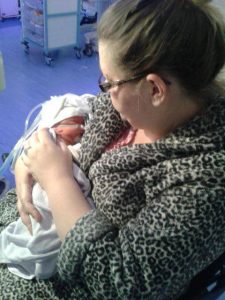
Many parents, as well as individuals with SA/CRS themselves, have questions about whether this condition resulted from an inherited gene, whether it can occur with other children in the family, or whether it can be passed down from parent to child. The question of whether or not SA/CRS is a genetic condition is a complex question. SA/CRS can occur for many different reasons. Some of the reasons it is thought to occur are genetic, some may be environmental reasons, and it may be due to a combination of both genetic and environmental factors. For the most part, no one knows the cause, and the cause is not the same for everyone.
The question is also complicated because the word “genetic” has several different meanings.
Genetic:
- An inherited trait passed down through one or both family members through several generations
- A spontaneous change in the genetic structure (i.e., mutation) that is not inherited but that occurs for the first time in the DNA of the embryo
- An inherited or spontaneous genetic trait that makes it more likely for the fetus or for the child later in life to develop certain traits, but only if certain environmental factors are also present
Research is ongoing, and there are not many research studies being done on this condition. Some information published in prior studies has later been proven invalid because of advances in DNA testing that was not possible in prior years. Therefore, very different information may be reported depending on the date of the research.
Finally, it is a complicated question because studies are typically done on single cases or very small populations, which means that broad claims related to genetic factors cannot be determined easily. Related to the rarity of the condition, among the more physically impacted individuals, childbirth is infrequent and is not possible for some. Genetic patterns in family histories among those with agenesis of the sacrum or part of the sacrum only, who may be more physically able to carry a child, is better understood than for those who have agenesis of the lumbar and part of the thoracic spine, because there may be physical complications that make pregnancy more difficult. Genetics are better understood for those who do not have congenital anomalies of the reproductive organs than for those who do.
Some things we know:
- In 4 known cases of individuals with SA/CRS (female) which included the high lumbar region who did give birth, none of their children had the condition of SA/CRS. Similarly, in pregnancies of women with SA/CRS that impacted only the lowest (sacral) region of their spines, none of their offspring had SA/CRS.
- In a review of literature and iSACRA group survey, only three known cases are reported where two children in the same family were both born with the condition of SA/CRS. In all other known families of two or more children, only one child was born with SA/CRS.
- In approximately 80% of families surveyed who went to genetics testing related to SA/CRS, no genetic indicators were found to explain the condition.
- Maternal diabetes is linked in some way, and diabetes itself may be genetic, but the link between SA/CRS and maternal diabetes is not fully understood. Most children born with SA/CRS do not have diabetic mothers.
- SA/CRS does not happen more frequently in males than females.
Various Types of SA/CRS associated with genetic syndromes
While no direct genetic cause for SA/CRS has been determined for most individuals with this condition, and while the condition does not appear to be passed down in families, there is a genetic syndrome where sacral or partial sacral agenesis may be one of the features of the syndrome. That condition is Currarino syndrome.
Currarino Triad
Some types of SA/CRS are tied to a specific gene. Currarino triad or syndrome is an autosomal dominant hereditary condition with three characteristics: sacral agenesis, anorectal malformation (most commonly in the form of anorectal stenosis) and presacral mass (a teratoma, and/or anterior sacral meningocele). Only 1 of every 5 individuals with Currarino triad has all three characteristics.
Currarino triad is caused by mutations in the MNX1 gene. This mutation may be passed down from family members but in 30% of the cases it occurs spontaneously. Less common is a complex phenotype of Currarino triad involving microdeletions of small pieces of DNA which includes MNX1 and other genes.
Currarino triad varies widely in severity. Up to 33% have no symptoms and may only be diagnosed during adulthood when X-rays and ultrasounds are done for different reasons. Currarino Triad does not usually involve absence of the spine above the sacrum. The first sacral vertebra is typically intact and half of the remaining sacrum. Each child has a 50% (1 in 2) chance to inherit that mutation when a parent carries this gene.
The following links may be helpful:
Patel RV, De Coppi P, Kiely E, and Pierro A. Currarino’s syndrome in twins presenting as neonatal intestinal obstruction–identical presentation in non-identical twins. BMJ Case Rep. September 8 2014; http://www.ncbi.nlm.nih.gov/pubmed/25199187.
Akay S, Battal B, Karaman B, and Bozkurt Y. Complete Currarino Syndrome Recognized in Adulthood. Journal of Clinical Imaging Science. 2015; 5:10. http://www.ncbi.nlm.nih.gov/pmc/articles/PMC4374199/.)
Cuturilo G, Hodge JC, Runke CK, Thorland EC, Al-Owain MA, Ellison JW, and Babovic-Vuksanovic D. Phenotype analysis impacts testing strategy in patients with Currarino syndrome. Clin Genet. January 2016; 89(1):109-114. http://www.ncbi.nlm.nih.gov/25691298.
VACTERL Association
Another condition where one of the features of the condition may include sacral agenesis is VACTERL Association. Unlike Curarino syndrome, no specific, consistent, genetic abnormality has been identified in individuals with VACTERL association. A small number of VACTERL association cases have been linked to mutations in FGF8, HOXD13, ZIC3, PTEN, FANCB, FOXF1, and TRAP1 genes and mitochondrial DNA.
VACTERL Association is a grouping of birth conditions impacting multiple parts of the body. An “association” means a group of specific features that happen together more often than it would happen due to chance alone, but for which no specific cause has been determined (idiopathic). The term VACTERL is an acronym with each letter representing the first letter of one of the more common findings seen in affected individuals: (V) = vertebral abnormalities; (A) = anal atresia; (C) = cardiac (heart) defects; (T) = tracheal anomalies including tracheoesophageal (TE) fistula; (E) = esophageal atresia; (R) = renal (kidney) and radial (thumb side of hand) abnormalities; and (L) = other limb abnormalities. Other features may include (less frequently) growth deficiencies and failure to thrive; facial asymmetry (hemifacial microsomia); external ear malformations; intestinal malrotation; and genital anomalies. Intelligence is usually normal.
The prediction for it to recur in either a sibling or a child is usually quoted as being around 1% (1 in 100). There are very few reports of recurrence of the VACTERL association in families in the literature.
VARIOUS FORMS OF SA/CRS
MRI studies indicate two categories of SA/CRS. These categories describe the formation and the spine and spinal cord. These two types of SA/CRS may have different causes.
Group 1:
The conus medullaris is blunt and terminates above the normal level; there is sometimes an associated dilated central canal or a cerebrospinal fluid–filled cyst at the lower end of the conus. These patients have major sacral deformities
Group 2:
The conus medullaris is elongated and tethered by a thickened filum terminale or intraspinal lipoma and ends below the normal level. Neurologic disturbances are more severe in this group
The answer to the genetic question is unclear
In summary, it cannot be confirmed that SA/CRS is genetic. Most trips to genetic counseling do not reveal any information related to this condition. However, because sacral agenesis describes a physical structure (the absence of the sacrum) there are genetic conditions which may include that same absence of this physical structure along with other features of that genetic condition, such as Currarino Triad. It can also not be confirmed that SA/CRS is wholly environmental (usually the “environmental factor” mentioned is maternal diabetes). Clearly there is some type of environmental influence but the specifics are unclear. It is likely that there are several different causes of SA/CRS, and there are many variations of the condition. The condition is not tied causes of spina bifida, though some individuals with SA/CRS have both. It is not related to “mermaid syndrome”, though early research associated the two. Parents with concerns about having a second child with SA/CRS should note that the indicators are less than 1/1000 chances of a second child being born with SA/CRS in the same family. There is no known case of a parent who has SA/CRS giving birth to a child with the same condition (with the exception of the genetic diagnosis of Currarino Triad). It is not uncommon for new parents to wrestle with emotions related to blame and guilt and articles under the parent section and the diagnosis secton of this site may be helpful.
